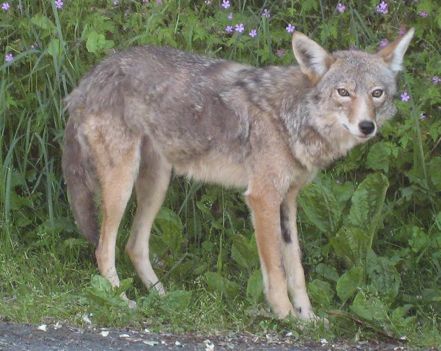(Editor’s note: After this recent WSB report and this recent Magnolia incident, it seemed like a good time to revisit the coyote question – as in, they’re living among us; should you be worried? The University of Washington is working with WSB and other small local news organizations again this semester, and one of their student journalists took on the assignment.)

(July 2008 photo from Vanessa, taken near Lincoln Park)
By EMILY FAIRBROOK
University of Washington News Lab
Jilly Eddy, a Gatewood resident, says she got “the heebie-jeebies” earlier this month when she found half a dead cat on her neighbor’s walkway.
All the signs pointed to coyotes, but before researching the topic, she had no idea they lived in her area. In the middle of this thriving city, it’s easy to forget that wild animals live just around the corner, or in some cases closer than that. Raccoons and squirrels are common, but it may come as a surprise that coyotes also call Seattle home.
Eddy’s property is on the edge of a large ravine, a common place for coyotes to live.
Kim Chandler, sergeant with the state Department of Fish and Wildlife, called these greenbelts “coyote superhighways.”
He gets calls about coyotes several times a week, but tells worried citizens not to lose any sleep over it.
The Seattle Animal Shelter also gets calls about coyotes a few times a month, but refers most callers to the Department of Fish and Wildlife.
“With any wildlife, if they’re injured, killed or diseased, we’ll pick them up,” said Ann Graves, enforcement supervisor at the shelter.
She recommends the standard tips: “Don’t approach it, steer clear, they’re more afraid of you than you are of them.”
Coyotes are indigenous in the area and protected by law. Unless the coyote is damaging crops or domestic animals on your property, a state license is required to hunt or trap them.
(WSB video of a coyote nosing around a Fauntleroy home in July 2008)
Occasionally the Department of Fish and Wildlife will trap aggressive coyotes, but it does not regularly control the coyote population.
“Very rarely do (coyotes) go after kids or people,” Chandler said. “Most coyote behavior is food-oriented. Period. That’s all they do: hunt and breed and sleep.”
On the other hand, people need to be educated. Chandler suggests reading the article, “Living with Coyotes,” which you can find on the Animal Shelter’s Web site.
“It’s very important we have an understanding with people that don’t know much about coyotes,” Chandler said. “You have to keep your garbage cleaned up. You can’t leave a bowl of pet food out on the deck — you’re just inviting trouble. Not only coyotes but raccoons and other rodents. It’s a must.”
After reading the article, Eddy wondered why she hadn’t heard all this before. Now, she’s doing her part by letting her cat out only during the day and considering fencing her yard. However, she notices that people leave out pet food or bird seed, unintentionally attracting critters for coyotes to prey on.
“It’s not going to work if I’m the only one in the neighborhood who’s doing something,” Eddy said, adding that she hopes her neighbors become more aware of how to live with coyotes.
Eddy suggested educating people through mailings that come from Seattle Public Utilities, since coyotes are attracted to leftovers in the garbage or compost bin.
Andy Ryan, who’s in media relations at Seattle Public Utilities, said the garbage cans they provide have locking lids and shouldn’t cause problems if closed properly.
“Basically it boils down to common sense,” said Chandler.
It’s true. With a few lifestyle modifications, residents can discourage coyotes from coming onto their property. It’s up to everyone to educate themselves and take action within their communities to work together to maintain a peaceful human-coyote coexistence.
Here are some things residents can do to protect themselves from coyotes (courtesy of the Department of Fish and Wildlife):
-Never feed coyotes
-Keep garbage cans secured and upright
-Prevent access to fruit and compost
-Feed dogs and cats indoors
-Prevent the buildup of feeder foods under bird feeders
-Keep dogs and cats indoors at night
-Keep shrubs pruned so coyotes can’t hide in them
-Build a coyote-proof fence
-Keep poultry in secure pens.
-Remove or bury dead livestock
DFW also made a video:
The complete “Living with Coyotes” article is on the Seattle Animal Shelter Web site:
www.seattle.gov/animalshelter/pdfs/LivingWithCoyotes.pdf
WSB coverage of coyotes is archived here (newest to oldest)
——————————————————————————————–
(EMILY FAIRBROOK is a student in the University of Washington Department of Communication News Laboratory.)


| 22 COMMENTS